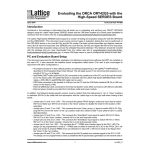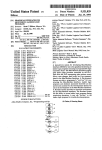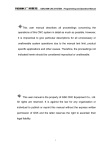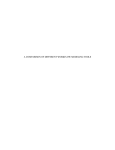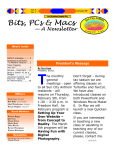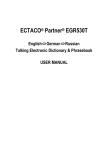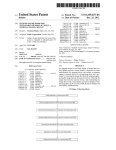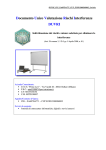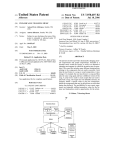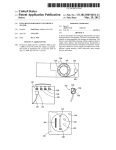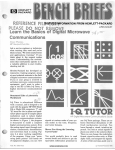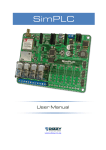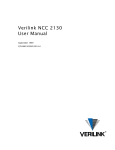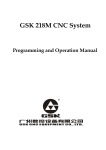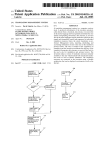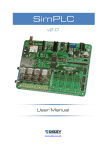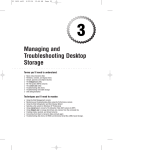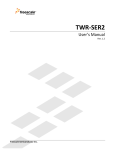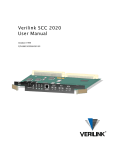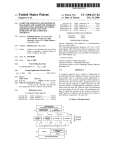Download m|||||mumlllllggmlggllitlglpn
Transcript
||||||m|||||mumlllllggmlggllitlglpn||||||||||||||||||||||| United States Patent [191 [11] Patent Number: Elpers et al. [45] Date of Patent: 5,519,719 May 21, 1996 [54] UNIVERSAL PATTERN GENERATOR TE820A User’s Manual, Tekelec (1988), pp. 4.3-7, §4.3, pp. 4.5-1 through 4.5-2, §4.5, pp. 4.5-5, §4.5, pp. 4.6-1 [75] Inventors: Mark D. Elpers, Minneapolis; John C. Lanphear, Eden Prairie, both of Minn. through 4.6-2, §4.6, pp. 4.6-5 through 4.6-8, §4.6, pp. 4.7-3 through 4.7-6, §4.7. ' Operating Manual, 3776B PCM Terminal Test Set (Includ [73] Assignee: ADC Telecommunications, Inc., Minneapolis, Minn. [21] Appl. No.: 810,207 [22] Filed: Dec. 19, 1991 [51] [52] Int. Cl.6 .................................................... .. G06F 11/00 US. Cl. ............................................ .. 371/27; 371/20.1 [58] Field of Search .. ....................... .. 371/27, 22.1, 37.1, 371/39.1, 15.1, 21.3, 20.1, 20.5; 455/67.1, 67.4; 379/10; 375/10 [56] 4,810,958 Bell Communications Research, Technical Reference TR-TSY-O00008, entitled “Digital Interface Between the SLC 96 Digital Loop Carrier System and a Local Digital Switch” (1987), pp. 3-1 through 3-14, §3. Bellcore, Technical Reference TR-TSY-O0O499, entitled References Cited “Transport Systems Generic Requirements (TSGR) : Com mon Requirements” (1988), pp. 9-1, §9.1.l.1, pp. 9-3 U.S. PATENT DOCUMENTS through 9-6, §9.1.2, pp. 9-7, §9.2, pp. 10-1 through 10-14, §10.2 3/1989 Mogi et al. ......................... .. 324/73 R 4,837,764 6/1989 4,964,124 10/1990 4,996,695 2/1991 Russello ..... . . . . .. Bunnett .... .. 371/20 371/15.1 Dack et al. .... .. 375/10 5,072,178 12/1991 Matsumoto 324/158 R 5,265,089 ing Options 001, 002, and 004) Hewlett Packard (1984), pp.4-4, §4-24, pp. 4-4, §4—25, pp. 4-4, §4-27, pp. 4-5, §4-34, pp. 4-5, §4-35, pp. 4-5, §4-36, pp. 4-5, §4-37 pp.4-5, §4-38, pp. 4-5, §4-39, pp. 4-6, §4-40 pp. 4-6, §4-41, pp. 4-6, §4-42, pp. 4-9, §4—56, pp. 4-30, §4-123, pp. 4-30, §4-124, pp. 4-31, §4-129, pp. 4-31, §4-133, pp. 4-31, §4-134, pp. 4-31, §4-139, pp. 4-32, §4-144. Primary Examiner—Robert W. Beausoliel, Jr. Assistant Examiner—Phung My Chung Attorney, Agent, or Firm—Merchant, Gould, Smith, Edell, Welter & Schmidt 11/1993 Yonehara ................................ .. 370/15 [57] OTHER PUBLICATIONS Operating Manual, Pattern Generator/Error Detector, 3780A, Hewlett Packard (1983), p. 28, ‘H 7 and 8. Operating Manual, 3781B Pattern Generator, 3782B Error Detector, Hewlett Packard (1980), p. 3-3, ‘H 12 Through 15. Programming Note, Quick Reference Guide for 3781B Pattern Generator and 3782B Error Detector (1980), p. 3. Phoenix, 5575A T1 Micro BERT Test Set, Operation -Sec tion 3 (1989), pp.3-74 through 3-77, §3-6 and pp. 3-86 through 3-88, § 3-8. Operating Manual, T-BERD 211 T-Carrier Analyzer (1989), pp. 2-3, §2.3.1-1, pp. 2-3, §2.3.1-2, pp. 2-3, ABSTRACT A universal pattern generator generates a digital signal pattern. The generator includes a user programmable device for specifying a repeatable digital signal pattern. The pro grammable device allows for the selection of a framing structure having a number of channels. The programmable device also has input means for inputting data into the channels of the framing structure. A data set representing the repeatable digital signal pattern is generated. The data set is held in memory. A transmitter responsive to the data set held in memory repeatably transmits the repeatable digital signal pattern represented by said data set. 10 Claims, 7 Drawing Sheets §2.3.1-13. 30 46 p r32 42 PATTERN ( T’ 4s\ r34 ‘ r36 GENERATOR EDITING T some 1' 28 44 38 state T 4o US. Patent OF May 21, 1996 (D N Sheet 1 of 7 US. Patent May 21,1996 Sheet 2 of 7 9.3 an _/ £\:1~n\ .NKmo2hé5uz1o z6oc5ém2a8n wmuiétow on 98 N.9. . US. Patent May 21, 1996 Sheet 3 0f 7 5,519,719 /52 FIG. :5 24 14 COUNTER /54 RESET / 58 _/ ADDRESS <3 RAM D 7 A 59 T 1 / A o \56 mc:—u- /7o AMV /65 > COUNTER _/6" RESET 65 ../ ADDRESS <3 D 7 A T 1 RAM A o \62 68 / ERROR/ SELECT PAL OUT 5,519,719 1 2 UNIVERSAL PATTERN GENERATOR memory and a transmitter responsive to the data set repeat edly transmits the repeatable digital signal pattern generat ing the digital signal pattern. TECHNICAL FIELD OF THE INVENTION In one embodiment of the invention, the system allows for the selection of errors to be generated in the data of channels. The present invention relates generally to telecommuni cation test systems. More particularly, the invention relates Error data is generated corresponding to the errors selected to pattern generators for use in telecommunication test systems. BACKGROUND OF THE INVENTION 10 To develop and test telecommunications equipment, a and the data set generated has errors interjected therein as a function of the error data. According to another embodiment of the invention error rates, bursts, or single errors are speci?ed for the framing, logic, or line code of the repeatable digital signal pattern. myriad of transmitting equipment products have been uti Trigger circuitry interj ects the rate, burst or single errors into lized to generate and apply to the telecommunications the digital signal pattern. equipment varying errored digital signal patterns. These According to another embodiment of the invention, an additional data set representing an additional repeatable various equipment products, while functional, do not have the ?exibility or control to adequately generate the errored patterns necessary to thoroughly test the performance of telecommunications equipment. For example, the HP 3781, HP 3780, and HP 3782 pattern generators available from Hewlett-Packard offer high bit rates, but only provide SF superframing formats. Their error generation capabilities are digital signal pattern is stored in the memory. The input of the transmitter is switched between the data set for the 20 repeatable digital signal pattern and the additional data set. The digital signal pattern represented by the data set and the additional pattern represented by the additional data set are alternately transmitted. limited to producing a single error occurrence over which According to yet another embodiment of the invention, the user has no timing control, and only a limited selection the input of the transmitter is switched between the data set of error rates are possible. The Phoenix 5575A-Tl Micro for the repeatable digital signal pattern and the additional BERT available from Phoenix offers framed format genera 25 data set so that one iteration of either the digital signal tion of various framing formats and line codes. Its error pattern represented by the data set or the additional pattern generation capabilities allow single error occurrence or error represented by the additional data set is interjected into the rate generation of line code and framing bits, however, it transmittal of the other pattern. does not control which bits are errored. The T—Bird 211 T-Carrier Analyzer, available from T-Bird, can generate any number of consecutive frame bit errors, however, the gen 30 BRIEF DESCRIPTION OF THE DRAWINGS eration of the errors is limited to the pressing of a switch which generates the errored frame, limiting the switching ability of generating a good frame and then an errored framed when desired. The Tekelec TEB-ZOA-DSl Frame FIG. 1 is a perspective view showing the universal pattern generator of the present invention for use in testing tele~ 35 Simulator and Analyzer, available from Tekelec, provides various generating and erroring capabilities, but will not provide ZBTSl line coding or the generation of Facility communications equipment; FIG. 2 is a block diagram of the software utilized with the universal pattern generator of FIG. 1; FIG. 3 is a block diagram of a RAM based transmitter of Data Link messages and lacks the control necessary to patterns. In addition, errors can only be inserted into uner rored framed patterns, as opposed to inserting errors into an the universal pattern generator of FIG. 1; FIG. 4 is a block diagram of the AMI/ERROR/SELECT/ PAL of the transmitter of FIG. 3; and already errored pattern. The various pattern generator products utilize hardware played during the use of the present invention. quickly switch between errored and unerrored generated customized or speci?c to the assembly of the user speci?ed FIGS. 5-9 are softkey menus and screen displays dis— 45 channel content, framing, signal bits, etc. Therefore, when changes are made in the speci?cations of the framing patterns, data link formats, and the like, the products require DETAILED DESCRIPTION OF THE INVENTION hardware modi?cations to meet the new requirements. Thus, there is a need for a universal error pattern generator which In the following detailed description of the invention, provides ?exible and detailed pattern control to test the performance of telecommunications equipment, and which could replace the myriad of pattern generator products now available. 55 SUMMARY OF THE INVENTION The present invention is a system for generating digital signal patterns. The system is prograrnmably controlled so the user has ?exibility and detailed pattern control when testing the performance of telecommunications equipment. The system includes a user programmable device for speci~ references are made to the accompanying drawings which form a part hereof, and which show by way of illustrations speci?c embodiments in which the invention may be prac ticed. It is to be understood that other embodiments may be utilized and structural changes may be made without depart ing from the scope of the present invention. Referring to FIGS. 1-9, the preferred embodiment of the Universal Pattern Generator of the present invention will be described. FIG. 1 shows a perspective view of the Universal Pattern Generator 10 coupled to test equipment units 16. Generator 10 includes a user-programmable unit 12, includ ing a computer or microprocessor and having a display 18, fying a repeatable digital signal pattern. The programmable softkeys 20 (and corresponding softkey display 90) and device allows for selecting a framing structure having a other input keys 22. The user programmable unit 12 allows the user to specify a repeatable digital signal pattern and plurality of channels, and includes an input for inputting data into the channels. A data set representing the repeatable digital signal pattern is generated. The data set is stored in error the data in that pattern as will be described in detail below. 5,519,719 4 3 SF, ESF, and SLC represent DSl rate superframing for The user programmable unit 12 generates a data set representing an errored or unerrored repeatable digital signal mats. As is known in the art, the SF superframing format is an assembly of 12 frames, each frame consisting of 24 8-bit pattern and the data set is stored in memory of a RAM based transmitter 14 via bus 24, a multi-bus in the preferred embodiment. The transmitter 14 is responsive to the data set samples of conversations, each 8-bit sample forms a separate channel conversation. The frame also includes an extra bit called the F-bit or the frame bit. Thus, each frame includes stored in the memory and repeatedly transmits the repeatable digital signal pattern represented by the data set by continu 193 bits per frame. In the SF superframing format, the F-bits from the odd numbered frames, the “Ft bits” of FIG. 5, are ously resetting a counter for addressing the memory of the RAM based transmitter 14. Thus, the errored or unerrored digital signal pattern is generated, transmitted, and applied via line 26 to equipment units 16. The generator provides set to the pattern 101010 to allow a receiving device to 10 frame. The F-bits from the even numbered frames, the “Fs universal unerrored or errored T1 pattern generation and is capable of adding new features and generating new patterns therewith by creating new software, without redesigning the hardware of the generator. It will be recognized by those skilled in the art that T-1 refers to speci?c telecommunica tions networks for transmitting data over speci?c framing structures and timings and is well recognized by those bits” of FIG. 5, are set to the pattern 001110 to allow a 15 carried on such networks is disclosed in Bellcore Technical receiving device to identify which frame is the ?rst frame and which is the last frame of a superframe. FIG. 6 displays the structure of an ESF superframing format screen. As is known in the art, the ESF superframing format is an assembly of 24 frames. The F-bits from frames 4, 8, 12, 16, 20 and 24, the “Fe bits”, are set to the pattern skilled in the art. A more detailed description of such networks and the framing structure and timing of signals maintain synchronization with the frames within the super 001011. These bits provide frame synchronization and 20 superframe synchronization. The F-bits from frames 2, 6, 10, 14, 18 and 22, the “CRC-6 bits”, are used as a check-sum Reference TR-TSY-000499, “Transport Systems Generic Requirements (TSGR): Common Requirements”, 1988. of the previous superframe transmitted. The remaining Software 30 associated with the user programmable unit 12 is shown in block diagram in FIG. 2. The software 30 includes pattern speci?cation software 32 for specifying a error rate information. F-bits, known as “FDL bits”, are generally used to relate 25 repeatable digital signal pattern in conjunction with the use of editing software 34 in response to user input 28 and generating a representative data set 42 of the repeatable The last superframing format screen, FIG. 7, shows the SLC, also referred to as SLC-96, superframing format. It is an assembly of six SF superfrarnes. The F~bits from the odd numbered frames, the “Ft bits” , are utilized in the same manner as for the SF superframing format. The even num speci?ed pattern. The representative repeatable data set 42 is 30 bered F~bits of frames 2—16 and 66—72, the “Fs bits”, stored in computer RAM of user programmable unit 12. function like the Fs bits of the SF superframing format. The Editing software 34 allows the user through user input 46 to remaining even Fs bits of frames 18—64 are FDL bits and edit the structure of the representative data set 42. Software provide a facility data link, generally used to transmit error 30 also includes mark errors software 35 for marking errors in the representative data set 42 through user input and 35 rate information as in the ESF superframing format. provides for generation of a marked error repeatable data set In addition, as is known in the art, robbed-bit signalling representative of the data set 42 and the user inputted may be utilized in all three superframing formats to provide marked errors applied to generator control software 86 in an communication between the sources and sinks of the system. additional array of data via line 37. An errored or unerrored In the SF format, the 8th bit of every channel in the 6th and repeatable pattern 40 is generated under control of generator 12th frames of every superframe are used as A and B control software 36 when the repeatable data set 42 is signalling bits. In the ESF format the 8th bit of each channel directly applied thereto via line 38. The pattern 40 is a in the 18th and 24th frames are used in addition to the 8th marked errors pattern when the repeatable data set 42 and an bits in the 6th and 12th frames to provide A, B, C, and D additional array of data via line 37 is applied thereto. signalling bits. The SLC format uses the 8th bit in the 6th Further, under the control of generator control software 36, additional errored patterns are generated via the unerrored, 45 errored, or marked error repeatable data set, as described further below. The softkeys 20 and corresponding softkey display 90, other keys 22, and display 18, all of user programmable unit 12 form the user interface for generating the digital signal and 12th frames like that of the SF format, only repeated six times. 50 Each of these screens, FIGS. 5—7, when selected by the user and under the control of speci?cation software 32, displays the associated superframing structure. When there is no user input, the X’s of the display screens 92 default to l’s or FF, the hex code for all ones. When the SF, ESF, or pattern 40. FIGS. 5-9 show various display screens 92 with SLC softkey is selected, the associated softkey box is softkey displays 90 for use in generating the digital patterns. Softkey menu items shown by the softkey displays 90 in the ?gures shall be understood to represent also the correspond highlighted to indicate that the user is in that particular superframing structure menu. The other softkeys on the main menu remain the same because they are not dependent on whether the SF, ESF, or SLC key is selected. User input 28 to specify an unerrored repeatable pattern is inputted by the user via the screen and menu of softkeys of 55 ing software components carrying out the menu function. The speci?cation, generation, and transmittal of an errored or unerrored digital signal pattern will be described with particular reference to these screens and softkey displays. The pattern speci?cation software 32, FIG. 2, when 60 initiated displays a ?rst menu of softkey displays 90, FIG. 5. Depending upon whether the SF, ESF, or SLC softkey is FIG. 8 (under control of editing software 34) which appears after the Edit Structure softkey of the screens, FIGS. 5—7, is selected. The data, in hex code, for the channels, robbed-bit signalling, number of super frames, FDL pattern length and selected a different screen will be displayed therewith. If the FDL content are inputted to specify an unerrored repeatable SF softkey is selected then display screen 92 of FIG. 5 is displayed. The screen 92 of FIG. 6 is displayed if the ESF key is selected and the display screen 92 of FIG. 7 is pattern by using either arrow key navigation around the displayed if the SLC softkey is selected. 65 ?eld, and then entering of data therein on the display, or using certain alphanumeric keys of the user programmable unit. Errors can also be speci?ed as described below. 5,519,719 5 6 The Next Channel softkey of the ?rst menu, FIGS. 5-7, increments the channel displayed and displays the data stored in the next channel. The Previous Channel softkey decrements the channel displayed. The Mark Errors softkey will be described below with regard to the mark errors software 35. When the Load QRSS softkey is selected a quasi-random pattern is created and loaded into the trans mitter 14, as described further below, for transmission. The errors software 35, FIG. 2. When an error is marked, the actual data set of the repeatable signal pattern 42 does not change but rather a bit is set in an additional data array so that the marked data bit is inverted upon loading of trans mitter 14 under control of generator control software 36. The marked data bits are highlighted when the bits are displayed on the main menu, FIG. 5, 6, or 7. The following table shows representative bytes of an unerrored generated repeatable pattern data set. quasi-random pattern is generated according to the algo rithm, xl5+ xl41+1=O. TABLE 1 After or while the user is specifying the framing structure and editing the screen ?elds, via the main menu, FIGS. 5—7, l-Iex speci?cation software 32, and, edit structure screen, FIG. 8, fin'ther de?nition to the pattern to be generated can be provided through the Edit Structure softkey of the main Ordinary unerrored “1" 01 0000 0001 + l Ordinary 02 0000 0010 — l 00 0000 0000 NA 0 80 1000 0000 NA 0 polarity because of line coding Ordinary 20 correspond to that particular superframing format is dis played. For example, the screen of FIG. 8 displays frame and channel information of the ESF superframing format. The edit structure screen, FIG. 8, allows the user to edit Bit negative 34. The edit structure screen 92 and softkeys 90 are the same such parameters as the channel content, robbed-bit signal Polarity unerrored “1", menu, SF, ESF, or SLC menus, FIGS. 5-7, and softkey menu and screen of FIG. 8 under the control of editing software whether you are in the SF, ESF, or SLC superframing format mode, except that the frame and channel information which Binary unerrored “0” “0" with repeat bit set, specifying end of pattern 25 ling, the number of superframes in the pattern, the facility When the user is satis?ed with the repeatable pattern he has created and marked, a particular hardkey is selected to data link (FDL), length and content, as well as the type and initiate the appearance of the generator control menu asso quantity of bi-polar violations (BPV’s), logic errors, and framing errors. The user can specify, for example, robbed-bit signalling by toggling the signalling function of screen 92, 30 allows the user to exercise control over the generator’s pattern switching and error generation capability. FIG. 3 shows the RAM based transmitter for generating and transmitting the digital signal pattern. The RAM based FIG. 8, from the “off” state to the “on” state, then navigating through the ?eld to specify the content of the A, B, C or D bits in each charmel by use of arrow key navigation or the other keys to specify data where required. ciated with the generator control software 36, shown by the softkey display 90, FIG. 9. The generator control menu selected. The AMI softkey toggles between each of these selections and AMI line coding is the default setting if transmitter 14 includes a side A 52 and a side B 60. Both sides operate in the same manner. Side A includes RAM 56 connected to a counter 54, likewise Side B includes RAM 62 and counter 64. The data set 42 representing the repeatable digital pattern is loaded into either side A or side B via the bus 24. Power up initializes either counter 54 or 64 which drives an address bus for addressing the data set. The another is not selected. The Next Channel and Previous Channel softkeys perform the same functions as before with respect to the main menu, FIGS. 5-7. The Save File softkey addressed data is applied to the input of the AMI/ERROR! SELECT PAL 70. The PAL 70 will be described later with regard to error generation. The seventh bit of the last word The Boot Emulator softkey simply boots the emulator 35 which controls the generator in the product as now struc tured. The AMI softkey allows the user to specify a line code for the pattern. Either AMI, B8ZS, or ZBTSI may be allows the user to save the ?le he just edited or initially 45 of data in the data set 42 representing the end of the repeatable digital pattern as shown in Table l, resets the speci?ed under a name of his own choosing in computer counters 54 or 64 via lines 58 or 66 so that the data set is memory and on disk or other storage media, and the Load repeatedly transmitted. By selecting the Load Generator softkey, FIG. 9, the data set representative of the presently displayed pattern speci?ed File softkey allows the user to call up previously saved ?les in order to edit them. Once the user has speci?ed the contents of the pattern by using the screens associated with the edit structure menu, by the user is loaded, under control of software 36, to whichever side of the generator that is not currently being selected for transmission. The line coding speci?ed in the FIG. 8, under control of editing software 34, and the main menu, Figs, 5, 6, or 7, under control of speci?cation software 32, the Edit Framing softkey of the edit structure menu is selected. When selected, a digital data set 42 representative 55 of the repeatable digital signal pattern speci?ed is generated and stored in computer RAM. Selecting the Edit Framing softkey, displays on the screen, frame by frame, the actual binary data set (display not illustrated). After selecting the Edit Framing softkey, the softkey Generator softkey remains highlighted until the loading is 60 display associated with the main menu once again is dis played, including the Mark Errors softkey, FIGS. 5, 6, or 7. As the binary data set is displayed frame by frame, the user is allowed to mark F-bits for error generation by highlight ing the bit using the arrow keys to navigate on the display and selecting the Mark Errors softkey. The capability of marking errors for generation is under the control of mark Edit Structure screen and menu, FIG. 8, is performed at this time. The data bits corresponding to the marked errors, if any, are also inverted according to the additional data array created under control of mark errors software 35. This Load completed. Thus, if the RAM based transmitter is transmit ting from side A 52, then it is possible to load into side B 60. The Load Generator softkey toggles between A and B. The Switch to A softkey, when selected, forces the generator to transmit from side A. This softkey is highlighted when the generator is transmitting therefrom. 65 The user interface allows the user to load a new pattern into side B as indicated above, during the transmission from side A and indicates this by labeling the softkey Load 5,519,719 7 8 Generator B. This would of course be true when side B is based transmitter 14. The edit structure screen, FIG. 8, and transmitting, whereby the softkey for loading is labeled pattern speci?cation software 32, allows the user to specify Load Generator A. Likewise, the Switch to B softkey forces the generator to transmit from side B and this key is a rate, burst, or single occurrence for a logic error. The edit structure screen, FIG. 8, indicates that the Logic Errors are in the off state, however, the state can be toggled to indicate single, burst or rate errors. When an error rate is selected by highlighted when the generator is transmitting therefrom. As previously presented, a digital signal pattern 40 can be the user as the single, burst or rate states are toggled, an additional display, shown as XX, allows the user to enter a desired rate. The same is applicable for the frame error generated under control of software 36 once it is speci?ed via pattern description software 32 utilizing editing software 34. This is shown in the software diagram of FIG. 2, wherein loop 38 applies the repeatable digital pattern data set 42 generated by the pattern description software directly to the generator control software 36. This pattern can be generated as speci?ed without errors being introduced therein. The unerrored digital pattern 40 per the user input 48 is generated as speci?ed by the user. Of course, the speci?ed repeatable digital pattern itself could be an errored pattern, thus the 10 capabilities. The selection of these types of logic errors or frame errors cause errors to occur on the ?y. These types of errors are post-line code generated and may disturb any line coding already performed on the data set. When a single, burst, or rate is specified, the user has no control over where the error will occur. When a single, burst, or rate is speci?ed 15 for logic or frame errors, a timer is con?gured (not shown) RAM based transmitter would transmit an errored pattern without ever generating an unerrored pattern. The apparatus and software of the present invention which applies, via lines 78 and 80 of in/out 65, signals representative thereof to the binary invertor 86 of PAL 70. The invertor 86 then inverts the digital pattern data set bits applied via data input lines 74 and 76 from output lines 59 interject errors into the speci?ed repeatable digital pattern to generate errored digital signal patterns in a number of ways. or 68. Line code errors or bi-polar violations (BPV’s) are also created by the user with the edit structure screen and menu, As was previously discussed, the Mark Errors softkey of the main menu, FIGS. 5, 6 or 7, allows the user to access the repeatable data set 42 and mark any given framing bit for inversion upon loading and transmission. Marking the error does not invert the actual data bit of the data set stored in computer RAM, but rather a bit is set in an additional array as previously described above and used to invert the bit prior to line coding and when the repeatable data set is loaded in transmitter 14. The data set 42 stored in computer RAM FIG. 8, and PAL 70 of transmitter 14. A single, rate or burst 25 con?gured (not shown) which applies via line 82 and 84 of in/out 65, signals representative thereof to the AMI encoder 30 pattern, accordingly. The user has no control over where in In the present invention, software has not been written to the pattern this BPV erroring will take place. As may be appreciated, software could easily be written allow all the bits, just the framing bits, of the speci?ed repeatable digital pattern to be marked for error generation per the Mark Errors softkey. It should be readily apparent to to allow the user to specify which bits (framing, data, signalling, etc. ) in the pattern are to be selected for logic or BPV errors when utilizing the burst, or rate generating capabilities. The hardware of the present invention would support such software. Although the present invention has been described above in a preferred form, those skilled in the art will readily appreciate that various modi?cations may be made to it one skilled in the art that software to mark errors for any of the speci?ed bits can easily be created. The marked error, because the bit in the repeatable digital signal data set is inverted when loaded, prior to transmission and is repeat edly transmitted, occurs every time the speci?ed repeatable pattern is repeatably transmitted. A logic errored digital signal pattern can also be generated 45 fying a repeatable digital signal pattern via the main menu, FIG. 5, 6 or 7, and the edit structure menu, FIG. 8, and then pattern into side A 60 of RAM based transmitter 14, a 50 an additional logic error created with the Mark Error softkey or Edit Structure software, can be loaded into side B of the a repeatable digital signal test pattern, said user pro grammable means including means for selecting a iteration of the errored pattern in side B is transmitted with 55 error control without interrupting the pattern framing. With the use of the Switch A-B-A softkey any of the bits of the repeatable digital signal pattern can be errored, including the data bits. This errored pattern is generated under generator control software 36. No additional software is required to T-1 timing, comprising: user programmable means for allowing a user to specify transmitter 14. By selecting the Switch A-B-A softkey, one the digital signal pattern 40 represented by the data set loaded into side A. This provides the capability of single without departing from the spirit and scope of the invention, as bounded by the claims of the application itself. What is claimed is: 1. A system for generating a digital signal test pattern for use in a T-1 data transmission system carrying primary signals formatted in any one of a plurality of predetermined T-1 framing structures and transmitted in a predetermined loading the data set representative of that digital signal duplicate of the digital signal pattern loaded into side A, with 88 of PAL 70. The AMI encoder 88 generates the BPV or line code error in the logic errored or unerrored digital signal remains unchanged. utilizing the Switch A-B-A softkey, or the ALT A-B-A-B softkey, FIG. 9, of the generator control menu. After speci BPV occurrence is speci?ed in the same manner as speci?ed for the logic and frame errors discussed above. When a single, burst or rate is speci?ed for BPV errors, a timer is 60 selected framing structure for said repeatable digital signal test pattern, said selected framing structure cor responding to a selected one of said predetermined T-l framing structures and having a plurality of channels, and input means for inputting data into said channels of said selected framing structure; means for generating a data set representing said repeat produce the single error capabilities. In addition, by select— ing the Switch A-B-A-B softkey, the patterns loaded in side able digital signal test pattern, said means for generat A and side B are alternately transmitted. Both logic errors and line code errors can be generated in 65 grammable means; the digital signal pattern by means of the edit structure screen and menu, FIG. 8, and the PAL 70, FIG. 4, of RAM ing a data set operatively connected to said user pro memory means for holding said data set; transmitting means responsive to said data set held in said memory means for repeatedly transmitting said repeat 5,519,719 10 9 able digital signal test pattern represented by said data framing structures and having a plurality of channels, and input means for inputting data into said channels of said selected framing structure; set to a receiving device for testing a performance of said receiving device at a rate selected to correspond to said predetermined T-l timing; means for generating a data set representing said repeat able digital signal test pattern, said means for generat ing a data set operatively connected to said user pro error means for selecting errors represented by a data entry for said channels inconsistent with said T-l grammable means; framing structure; and memory means for holding said data set; and transmitting means responsive to said data set held in said means for generating error data corresponding to errors selected, said means for generating a data set interject ing errors as a function of said error data. 1O 2. A system for generating a digital signal test pattern for use in a T-1 data transmission system carrying primary signals formatted in any one of a plurality of predetermined T-1 framing structures and transmitted in a predetermined T-1 timing, comprising: able digital signal test pattern represented by said data set to a receiving device for testing a performance of said receiving device at a rate selected to correspond to said predetermined T-1 timing; and 15 user programmable means for allowing a user to specify said user programmable means including means for selecting at least one of a line code, robbed bit signal ling, and data link messages for said repeatable digital a repeatable digital signal test pattern, said user pro signal pattern. grammable means including means for selecting a 7. A system for generating a digital signal test pattern for use in a T-l data transmission system carrying primary signals formatted in any one of a plurality of predetermined T-1 framing structures and transmitted in a predetermined selected framing structure for said repeatable digital signal test pattern, said selected framing structure cor responding to a selected one of said predetermined T-l framing structures and having a plurality of channels, T-l timing, comprising: and input means for inputting data into said channels of said selected framing structure; means for generating a data set representing said repeat memory means for repeatedly transmitting said repeat user programmable means for allowing a user to specify 25 able digital signal test pattern, said means for generat a repeatable digital signal test pattern, said user pro grammable means including means for selecting a ing a data set operatively connected to said user pro selected framing structure for said repeatable digital grammable means; signal test pattern, said selected framing structure cor responding to a selected one of said predetermined T-l framing structures and having a plurality of channels, and input means for inputting data into said channels of memory means for holding said data set; transmitting means responsive to said data set held in said memory means for repeatedly transmitting said repeat 30 said selected framing structure; able digital signal test pattern represented by said data means for generating a data set representing said repeat able digital signal test pattern, said means for generat ing a data set operatively connected to said user pro set to a receiving device for testing a performance of said receiving device at a rate selected to correspond to said predetermined T-l timing; and grammable means; error means for interjecting errors into said digital signal memory means for holding said data set; transmitting means responsive to said data set held in said pattern. 3. A system according to claim 2, wherein said error memory means for repeatedly transmitting said repeat means includes means for specifying one of a logic error rate, logic burst errors, and a single logic error for said able digital signal test pattern represented by said data repeatable digital signal pattern and trigger means for inter set to a receiving device for testing a performance of said receiving device at a rate selected to correspond to jecting said one of logic error rate, logic burst errors, and said predetermined T-1 timing; and single logic error into said digital signal pattern. framing burst errors, and a single framing error for said said transmitting means further comprises an input con~ nected to said memory means for receiving said data set, and wherein an additional data set representing an repeatable digital signal pattern and trigger means for inter additional repeatable digital signal pattern is stored in 4. A system according to claim 2 wherein said error means 45 includes means for specifying one of a framing error rate, said memory means, and further comprising means for jecting said one of framing error rate, framing burst errors, and single framing error into said digital signal pattern. 50 5. A system according to claim 2 wherein said error means includes means for specifying one of a line code error rate, line code burst errors, and a single line code error for said switching the input of said transmitting means between the data set for the repeatable digital signal pattern and the additional data set for the additional repeatable digital signal pattern, so that one iteration of one of said repeatable digital signal pattern and trigger means for inter repeatable digital signal pattern and said additional jecting said one of line code error rate, line code burst errors, 55 repeatable digital signal pattern represented by said and single line code error into said digital signal pattern. 6. A system for generating a digital signal test pattern for data set and said additional data set, respectively, is interjected into the other one of said repeatable digital use in a T-1 data transmission system carrying primary signals formatted in any one of a plurality of predetermined T-l framing structures and transmitted in a predetermined signal pattern and said additional repeatable digital signal pattern that is being repeatedly transmitted. 8. A method for generating an errored digital signal T-l timing, comprising: pattern for use in a T-1 data transmission system carrying primary signals formatted in any one of a plurality of predetermined T-l framing structures and transmitted in a user programmable means for allowing a user to specify a repeatable digital signal test pattern, said user pro grammable means including means for selecting a selected framing structure for said repeatable digital signal test pattern, said selected framing structure cor responding to a selected one of said predetermined T-l 65 predetermined T-1 timing, comprising the steps of: specifying a repeatable digital signal pattern by: a) selecting a framing structure for said repeatable digital signal pattern and corresponding to a selected 5,519,719 12 11 said predetermined T-1 timing for testing a per formance of said receiving device. 9. A method according to claim 8 wherein said specifying one of said predetermined T-1 framing structures, said framing structure having a plurality of channels; and b) inputting data into said channels of said framing step further includes selecting at least one of a line code, robbed bit signalling, and data link messages for said structure; selecting errors for said data in said channels by repeatable digital signal pattern. selecting a data entry for a channel which is incon sistent with said T-l framing structure; 10. A method according to claim 8 wherein said step of generating said errored digital signal pattern by: i) loading a data set representative of said repeatable digital signal pattern and said selected error data into memory of a transmitter; and ii) repeatably transmitting said repeatable digital signal pattern represented by said data set to a receiving device at a rate selected to correspond to 10 specifying a repeatable digital signal pattern includes the step of specifying one of an error rate, burst errors, and a single error for at least one of framing errors, logic errors and line code errors of said repeatable digital signal pattern.














